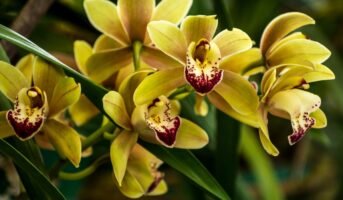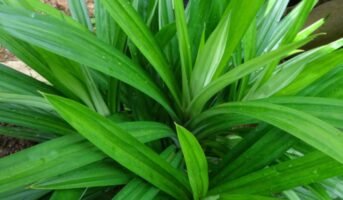
Source: Adobe stock
What is Datura Innoxia?
Datura Innoxia is a flowering plant of the family Solanaceae. The plant is native to Southwestern United States, Central and South America. The plant has been introduced to regions of Asia, Africa, Europe, and Australia. It’s a subshrub with a tuberous root that reaches 0.6 to 1.5m in height. The stems and leaves of this plant are covered in soft greyish hair, hence giving the plant a greyish appearance. The whole plant emits a foul odour, however, the fragrance of the flowers is quite pleasant when it blooms at night.
Datura Innoxia- Fact sheet
| Common Name | Angel’s Trumpet |
| Botanical Name | Datura Innoxia |
| Other common Names | Pricklyburr, Recurved thorn-apple, Downy thorn-apple, Indian-apple, Lovache, Moonflower, Nacazcul, Toloatzin, Toloaxihuitl, Tolguache or Toloache |
| Family | Solanaceae |
| General Description | This is a tender herbaceous perennial, often grown as an annual plant, with a 3-foot spread. It is found in sandy or dry, open spaces. |
The Genus
Datura is the genus of Datura Innoxia
Native habitat
Known as the Angel’s trumpet, Datura inoxia is native to Mexico and Central America
Sun tolerance
Datura Innoxia grows in full sunlight. It is a drought tolerant plant and hence can grow in any type of soil.
Mature height
Datura innoxia grows upto a height of 0.6 m to 1.5 m
Leaves
The Datura innoxia leaves 10–20 cm in length, 15–18 cm in width and grow alternate.
Crown shaft
The Datura innoxia has a spreading crown
Leaf colour
The leaves are green in colour, rough, and fragrant. There are hairs on the leaves, and the size is more than 6 inches in length.
Cold tolerance
Hardy to -6 degree Celsius, the Datura Innoxia plant is grown as an annual plant in places with cold conditions.
Self pruning characteristic
The Datura Innoxia hardly needs pruning as the dead foliage actually acts as insulation against the cold for the plant.
Growth Rate
They have a very good growth rate and grow rapidly.
Fruit
The fruits are showy and in a capsule shape. The capsule splits when ripe to disperse the seeds. The seeds are viable for a long time and can remain dormant in the soil for many years.
Flowers
The plant has seven to eight-inch white, pink, and lavender tubular flowers. The flowers bloom at night only.
Distribution
Datura Innoxia is a native plant to tropical and subtropical regions of the Americas from the Southwestern US to Mexico, through Central America, and Northern and Western South America. It is a species that has also naturalized in the Caribbean islands. The plant has been widely introduced to other tropical areas and thrives there. It is an invasive species in some areas and has then naturalised to grow there.
Biology and ecology
The flowers bloom overnight and are pollinated by moths. Hummingbirds also visit the flowers but are affected by the chemicals in the flowers, and thus, their consumption is less. Honeybees are not affected. Datura Innoxia can flower and produce fruits throughout the year, however, in India, the plant only flowers from the months July to September. Germination of the seed is slow and poor.
Cultivation
The plant is found in a variety of soils but prefers well-drained soils. Maximum germination happens with continuous light and at 25 to 30 degrees Celsius temperatures. Datura Innoxia is naturally found in eroded areas, vacant lots, overgrazed pastures, and uncultivated fields. Disturbed areas with no competition appear to be the requirements for these plants. It can sustain mean annual rainfall of 500 to 1500mm. Soil drainage should be free. Acid to neutral pH soils are preferred, and the texture should be soft. The plant’s dispersal is solely dependent on its seeds which are produced in large quantities. Many of the Datura Innoxia plants have been intentionally introduced in other regions as ornamental plants.

Source: Medicinallive
Uses of Datura Innoxia
For use in traditional medicine, it is a reputed treatment for rabies, dog bites and poisonous insect bites. Many native Americans have used the plant as a treatment for hallucinations. The Aztecs have long reported using it as a medication against wounds. Because of its great toxicity, a great deal of experience and thorough knowledge is needed to use this plant medicinally.

Source: Amazon.in
Care
Datura Innoxia needs full sunlight, fertile soil, and regular watering. If adequate moisture is not received, then the plant gets droopy. During the winter, the plants sustain themselves by how much moisture they get. Potted plants need special attention and repotting annually. If left out in milder climates, the plants may lose their leaves. If grown in cooler climates, the plants need to be kept indoors. The plants can be fertilized in spring with food that is high in nitrogen. Subsequently, food with higher phosphorus content is needed to help with flowering. There is no necessity to prune this plant.
Toxicity
All parts of the plant, particularly the seeds, are known to be toxic and may be fatal if ingested by humans and animals. The plant contains two main toxic alkaloids, atropine and scopolamine. In some areas, Datura plants are forbidden to be bought, sold, or grown. The plant has been known to be used as a poison for many centuries. The toxicity of the plant depends on its growth stage, where it is being grown, and the local weather conditions. The foul smell and bitter taste prevent livestock from consuming the plant.
Control
Isolated plants should be hand-pulled, whereas weeds are controlled when the plant is in the seedling stage for large areas of infestation. Cultivation becomes difficult as the stems become woodier, and the roots cannot be completely severed as the plant matures. Seedlings take time to emerge, so repeated cultivations are needed to help hinder infestations. Chemically, the plant can be controlled via herbicides at earlier growth stages. As the plant matures, it becomes resistant to herbicides.
Conclusion
Datura Innoxia is also known as a devil’s trumpet because of its inflorescence, interesting shrub, and ornamental value. These plants are large with coarse textures and often used as annual paintings. The white flowers are often included in gardens due to their white flowers that bloom at night and are fragrant in the evenings. These plants are, however, toxic and need to be handled with gloves. Due to its toxicity, pets and toddlers should be kept away. The plant, with its remarkable blooming, is a sight to see.
FAQs
How long do the seeds take to grow?
The seeds germinate in fifteen to twenty days.
Is the plant dangerous to touch?
No, however, the plant and all of its parts can prove fatal if eaten
Diseases and pests that may infect the Datura Innoxia plant?
It avoids attacks by herbivores due to it being toxic. Fungal infections may occur that will spot the leaves. A few fungi are there that cause root rots. Viral diseases may cause leaves to fold and wilt. Insects such as Aphids can be seen visibly and cause viral infections.
A smart tip for growing a Datura Innoxia Plant?
Add a bit of fertilizer during blooming to enhance it.
Short facts of the Datura Innoxia Plant?
The plant loves light and flowers all summer long. It is vulnerable to cold conditions. It is an evergreen plant. The best time to plant is in spring. The plant is highly used as an ornamental plant. The plant should be watered well.
| Got any questions or point of view on our article? We would love to hear from you.Write to our Editor-in-Chief Jhumur Ghosh at [email protected] |
Housing News Desk is the news desk of leading online real estate portal, Housing.com. Housing News Desk focuses on a variety of topics such as real estate laws, taxes, current news, property trends, home loans, rentals, décor, green homes, home improvement, etc. The main objective of the news desk, is to cover the real estate sector from the perspective of providing information that is useful to the end-user.
Facebook: https://www.facebook.com/housing.com/
Twitter: https://twitter.com/Housing
Email: [email protected]











